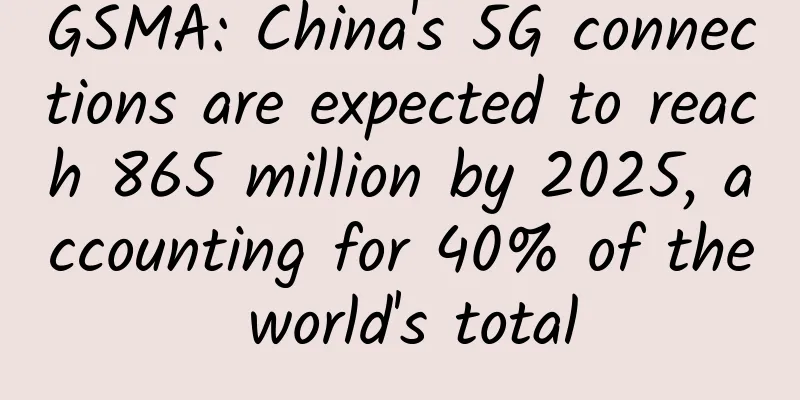GSMA: China's 5G connections are expected to reach 865 million by 2025, accounting for 40% of the world's total

|
Statistics from GSMA Think Tank, a GSMA research institute, show that by the end of the third quarter of 2021, the number of 5G networks worldwide had grown to 176, with 5G connections reaching approximately 550 million. China's 5G connections account for 78% of the world's total 5G connections, or approximately 430 million. By the end of 2021, nearly 8% of the world's consumer groups, or approximately 640 million users, will use 5G. The continued network construction of operators plays a vital role. It is expected that by the end of 2021, the 5G penetration rate in South Korea and China will exceed 30%, accounting for 32% and 30% of the total mobile connections respectively. It is expected that by 2025, the total number of 5G connections in China will reach 865 million, accounting for 40% of the total number of 5G connections in the world, and China's 5G penetration rate will exceed 50%. Against the backdrop of the rapid global deployment of 5G, the revenue structure of global operators has changed. In addition to traditional telecommunications revenue, revenue from new services has increased significantly, and China's performance in revenue growth has been particularly impressive. Data shows that in 2017, traditional telecom services, including fixed-line, fixed-line, mobile SMS, voice, data, etc., accounted for 82% of operators' revenue; new services, such as pay TV, OTT video, media and advertising, games, IoT, cloud, security, commercial and financial services, smart home services, and vertical industry solutions, accounted for only 18%. By 2020, the proportion of traditional telecom service revenue in total revenue will drop to 76%, while the proportion of new service revenue outside traditional telecom services will increase to 24%. Among them, China leads the world in revenue growth outside of traditional telecommunications services. In 2020, the average year-on-year growth rate of global operators' revenue outside of traditional telecommunications services was 9%, while China's figure reached 26%, far higher than the global average. 5G is an important catalyst and driving force. China's three major operators, China Mobile, China Unicom, and China Telecom, doubled their revenue outside of traditional businesses in 2020 compared with 2017, reaching RMB 230 billion, of which the growth of B2B business was the main driving force. Cloud revenue increased sevenfold from 2017 to 2020, and revenue from the Internet of Things and data each doubled. It is expected that by the end of 2021, the 5G penetration rate in South Korea and China will exceed 30%, accounting for 32% and 30% of the total mobile connections respectively. It is expected that by 2025, the total number of 5G connections in China will reach 865 million, accounting for 40% of the total number of 5G connections in the world, and China's 5G penetration rate will exceed 50%. Against the backdrop of the rapid global deployment of 5G, the revenue structure of global operators has changed. In addition to traditional telecommunications revenue, revenue from new services has increased significantly, and China's performance in revenue growth has been particularly impressive. Data shows that in 2017, traditional telecom services, including fixed-line, fixed-line, mobile SMS, voice, data, etc., accounted for 82% of operators' revenue; new services, such as pay TV, OTT video, media and advertising, games, IoT, cloud, security, commercial and financial services, smart home services, and vertical industry solutions, accounted for only 18%. By 2020, the proportion of traditional telecom service revenue in total revenue will drop to 76%, while the proportion of new service revenue outside traditional telecom services will increase to 24%. Among them, China leads the world in revenue growth outside of traditional telecommunications services. In 2020, the average year-on-year growth rate of global operators' revenue outside of traditional telecommunications services was 9%, while China's figure reached 26%, far higher than the global average. 5G is an important catalyst and driving force. China's three major operators, China Mobile, China Unicom, and China Telecom, doubled their revenue outside of traditional businesses in 2020 compared with 2017, reaching RMB 230 billion, of which the growth of B2B business was the main driving force. Cloud revenue increased sevenfold from 2017 to 2020, and revenue from the Internet of Things and data each doubled. From techweb |
<<: China Automobile Dealers Association: Used Car Weekly Report from November 8 to 14, 2021
>>: A sober reflection on the "ecological" effect behind the crazy "LeTV 919"
Recommend
Tencent advertising home industry placement strategy!
1. Overview and analysis of the residential furni...
Where does the contribution of “brand planning” lie?
As you know, I have been taking on some brand pla...
Tips for writing Weibo operation plans!
Many new media operators probably have only a vag...
How can the education and training industry effectively attract new customers? Share 3 tips!
Difficulty in recruiting students and high costs ...
Taking Jianshu as an example, let’s explore how UGC content products are cold started!
What is a cold start and how to do it? Is there a...
World Beauty Day丨The most cost-effective "beauty" method, you may have been doing it wrong
November 7th of each year is World Beauty Day, wh...
CNNIC: As of June 2023, the number of Chinese netizens will reach 1.079 billion and the Internet penetration rate will reach 76.4%
China Internet Network Information Center (CNNIC)...
Apple closes iOS 11.4.1 verification channel: iOS 12 downgrade is completely hopeless
Today, Apple pushed the official iOS 12.0.1 syste...
Do children really grow faster in spring?
Children today are faced with many challenges alo...
UX Lessons Learned from Seven Classic Fairy Tales!
Master screenwriter Robert McKee once wrote: Stor...
Google announces multiple measures to optimize Android subscription system for emerging markets
At its I/O developer conference, Google announced...
I analyzed 100 cases and summarized 3 ways to create creative Dragon Boat Festival activities
When I opened my eyes on the morning of May 2, I ...
SEM data report, how to view keyword report and search term report?
Keyword report and search term report , these two...
Is it reliable to judge whether you have cancer based on "early symptoms"? Don't wait until the late stage to discover cancer!
Recently, a "self-media" account fabric...
How dirty is the frequently cleaned water dispenser? The measured data is a bit heartbreaking
Water dispensers are prone to accumulating dirt a...









